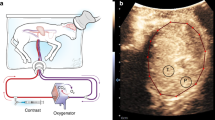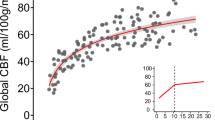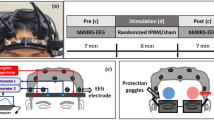Abstract
The sleep-wake cycle has been studied extensively in both adult and fetal mammalian species with emphasis in different areas. Fetal studies have focused on characterization of behavioral states and responses to challenges such as hypoxia, and there have been relatively fewer studies that have investigated the control of fetal behavioral state. The objective of this study was to determine whether cerebral blood flow during cholinergically induced fetal behavioral states was similar to that during spontaneous fetal behavioral states in chronically catheterized near-term sheep fetuses. Injection of carbachol (1.25 μg) into the cisterna magna increased the duration of the subsequent low-voltage electrocortical epoch. Scopolamine infusion (0.3 mg) increased the duration of the subsequent high-voltage electrocortical activity epoch. Cerebral blood flow and oxygen delivery were higher during both spontaneous and carbachol-induced low-voltage/rapid eye movement behavioral state than during spontaneous and scopolamine-induced high-voltage/non–rapid eye movement behavioral state. Thus, pharmacologic manipulation of fetal behavioral state induced a state that resembled spontaneous fetal behavioral state both electrophysiologically and metabolically. This study shows that inducing extended periods of a desired fetal behavioral state is possible and that this method may be used to study their function.
Similar content being viewed by others
Log in or create a free account to read this content
Gain free access to this article, as well as selected content from this journal and more on nature.com
or
Abbreviations
- CBF:
-
cerebral blood flow
- CMR:
-
cerebral metabolic rate
- EMG:
-
electromyograph
- FBM:
-
fetal breathing movements
- HV:
-
high-voltage
- LV:
-
low-voltage
- NREM:
-
non–rapid eye movement
- REM:
-
rapid eye movement
References
Szeto HH, Vo TD, Dwyer G, Dogramajian ME, Cox MJ, Senger G 1985 The ontogeny of fetal lamb electrocortical activity: a power spectral analysis. Am J Obstet Gynecol 153: 462–466
Clapp JF 3rd, Szeto HH, Abrams R, Larrow R, Mann LI 1980 Physiologic variability and fetal electrocortical activity. Am J Obstet Gynecol 136: 1045–1050
Parkes MJ 1992 Fetal behavioural states: sleep and wakefulness?. Q J Exp Psychol B 44: 231–244
Richardson BS, Caetano H, Homan J, Carmichael L 1994 Regional brain blood flow in the ovine fetus during transition to the low-voltage electrocortical state. Brain Res Dev Brain Res 81: 10–16
Richardson BS, Patrick JE, Abduljabbar H 1985 Cerebral oxidative metabolism in the fetal lamb: relationship to electrocortical state. Am J Obstet Gynecol 153: 426–431
Madsen PL, Schmidt JF, Wildschiodtz G, Friberg L, Holm S, Vorstrup S, Lassen NA 1991 Cerebral O2 metabolism and cerebral blood flow in humans during deep and rapid-eye-movement sleep. J Appl Physiol 70: 2597–2601
Lenzi P, Zoccoli G, Walker AM, Franzini C 2000 Cerebral circulation in REM sleep: is oxygen a main regulating factor?. Sleep Res Online 3: 77–85
Braun AR, Balkin TJ, Wesenten NJ, Carson RE, Varga M, Baldwin P, Selbie S, Belenky G, Herscovitch P 1997 Regional cerebral blood flow throughout the sleep-wake cycle. An H2(15)O PET study. Brain 120: 1173–1197
Gnadt JW, Pegram GV 1986 Cholinergic brainstem mechanisms of REM sleep in the rat. Brain Res 384: 29–41
Zoltoski RK, Velazquez-Moctezuma J, Shiromani PJ, Gillin JC 1993 The relative effects of selective M1 muscarinic antagonists on rapid eye movement sleep. Brain Res 608: 186–190
Bissonnette JM, Hohimer AR, Knopp SJ 1994 A cholinergic mechanism involved in fetal breathing during the high voltage ECoG state. Respir Physiol 96: 151–162
Morrison JL, Carmichael L, Homan J, Richardson BS 1997 The effects of ‘sleep promoting agents' on behavioural state in the ovine fetus. Brain Res Dev Brain Res 103: 1–8
Ouchi Y, Fukuyama H, Ogawa M, Yamauchi H, Kimura J, Magata Y, Yonekura Y, Konishi J 1996 Cholinergic projection from the basal forebrain and cerebral glucose metabolism in rats: a dynamic PET study. J Cereb Blood Flow Metab 16: 34–41
Barbelivien A, Bertrand N, Besret L, Beley A, MacKenzie ET, Dauphin F 1999 Neurochemical stimulation of the rat substantia innominata increases cerebral blood flow (but not glucose use) through the parallel activation of cholinergic and non-cholinergic pathways. Brain Res 840: 115–124
Richardson BS, Carmichael L, Homan J, Patrick JE 1992 Electrocortical activity, electroocular activity, and breathing movements in fetal sheep with prolonged and graded hypoxemia. Am J Obstet Gynecol 167: 553–558
Bissonnette JM, Hohimer AR, Richardson BS 1981 Ventriculocisternal cerebrospinal perfusion in unanesthetized fetal lambs. J Appl Physiol 50: 880–883
Joseph SA, Walker DW 1993 Effects of intracisternal monoamines on breathing movements in fetal sheep. Am J Physiol 264: R1139–R1149
Buckberg GD, Luck JC, Payne DB, Hoffman JI, Archie JP, Fixler DE 1971 Some sources of error in measuring regional blood flow with radioactive microspheres. J Appl Physiol 31: 598–604
Heymann MA, Payne BD, Hoffman JI, Rudolph AM 1977 Blood flow measurements with radionuclide-labeled particles. Prog Cardiovasc Dis 20: 55–79
Makowski EL, Schneider JM, Tsoulos NG, Colwill JR, Battaglia FC, Meschia G 1972 Cerebral blood flow, oxygen consumption, and glucose utilization of fetal lambs in utero. Am J Obstet Gynecol 114: 292–303
Richardson BS, Carmichael L, Homan J, Gagnon R 1989 Cerebral oxidative metabolism in lambs during perinatal period: relationship to electrocortical state. Am J Physiol 257: R1251–R1257
Bocking AD, Gagnon R, Milne KM, White SE 1988 Behavioral activity during prolonged hypoxemia in fetal sheep. J Appl Physiol 65: 2420–2426
Matsuda Y, Patrick J, Carmichael L, Fraher L, Richardson B 1994 Recovery of the ovine fetus from sustained hypoxia: effects on endocrine, cardiovascular, and biophysical activity. Am J Obstet Gynecol 170: 1433–1441
Ioffe S, Jansen AH, Russell BJ, Chernick V 1980 Sleep, wakefulness and the monosynaptic reflex in fetal and newborn lambs. Pflugers Arch 388: 149–157
Jensen A, Bamford OS, Dawes GS, Hofmeyr G, Parkes MJ 1986 Changes in organ blood flow between high and low voltage electrocortical activity in fetal sheep. J Dev Physiol 8: 187–194
Rurak DW, Gruber NC 1983 Increased oxygen consumption associated with breathing activity in fetal lambs. J Appl Physiol 54: 701–707
Gardner DS, Fletcher AJ, Bloomfield MR, Fowden AL, Giussani DA 2002 Effects of prevailing hypoxaemia, acidaemia or hypoglycaemia upon the cardiovascular, endocrine and metabolic responses to acute hypoxaemia in the ovine fetus. J Physiol 540: 351–366
Morrison JL 1996 The Effects of ‘Sleep Altering' Pharmacological Agents on Ovine Fetal Behavioural State. Department of Physiology, University of Western Ontario, London, p 114
Rankin JH, Landauer M, Tian Q, Phernetton TM 1987 Ovine fetal electrocortical activity and regional cerebral blood flow. J Dev Physiol 9: 537–542
Endo Y, Jinnai K, Endo M, Fujita K, Kimura F 1990 Diurnal variation of cerebral blood flow in rat hippocampus. Stroke 21: 1464–1469
Sokoloff L 1981 Relationships among local functional activity, energy metabolism, and blood flow in the central nervous system. Fed Proc 40: 2311–2316
Ogawa M, Magata Y, Ouchi Y, Fukuyama H, Yamauchi H, Kimura J, Yonekura Y, Konishi J 1994 Scopolamine abolishes cerebral blood flow response to somatosensory stimulation in anesthetized cats: PET study. Brain Res 650: 249–252
Elhusseiny A, Cohen Z, Olivier A, Stanimirovic DB, Hamel E 1999 Functional acetylcholine muscarinic receptor subtypes in human brain microcirculation: identification and cellular localization. J Cereb Blood Flow Metab 19: 794–802
Zoccoli G, Grant DA, Wild J, Walker AM 2001 Nitric oxide inhibition abolishes sleep-wake differences in cerebral circulation. Am J Physiol 280: H2598–H2606
Blin J, Ray CA, Piercey MF, Bartko JJ, Mouradian MM, Chase TN 1994 Comparison of cholinergic drug effects on regional brain glucose consumption in rats and humans by means of autoradiography and position emission tomography. Brain Res 635: 196–202
Ray CA, Blin J, Chase TN, Piercey MF 1992 Effects of cholinergic agonists on regional brain energy metabolism in the scopolamine-treated rat. Neuropharmacology 31: 1193–1199
Gitelman DR, Prohovnik I 1992 Muscarinic and nicotinic contributions to cognitive function and cortical blood flow. Neurobiol Aging 13: 313–318
Cohen RM, Gross M, Semple WE, Nordahl TE, Sunderland T 1994 The metabolic brain pattern of young subjects given scopolamine. Exp Brain Res 100: 133–143
Mirmiran M, Maas YG, Ariagno RL 2003 Development of fetal and neonatal sleep and circadian rhythms. Sleep Med Rev 7: 321–334
Czikk MJ, Green LR, Kawagoe Y, McDonald TJ, Hill DJ, Richardson BS 2001 Intermittent umbilical cord occlusion in the ovine fetus: effects on blood glucose, insulin, and glucagon and on pancreatic development. J Soc Gynecol Investig 8: 191–197
Grant DA, Franzini C, Wild J, Walker AM 1995 Continuous measurement of blood flow in the superior sagittal sinus of the lamb. Am J Physiol 269: R274–R279
Czikk MJ, Totten S, Homan JH, White SE, Richardson BS 2001 Sagittal sinus blood flow in the ovine fetus as a continuous measure of cerebral blood flow: relationship to behavioural state activity. Brain Res Dev Brain Res 131: 103–111
Acknowledgements
We thank the Canadian Institutes of Health Research for grants supporting this work. We also thank Drs. A. Bocking, R. Gagnon, J. Vazquez, and I.C. McMillen for ongoing interest in this work.
Author information
Authors and Affiliations
Corresponding author
Additional information
This work was supported by a grant from the Canadian Institutes of Health Research.
Rights and permissions
About this article
Cite this article
Morrison, J., Carmichael, L., Homan, J. et al. Cerebral Blood Flow during Spontaneous and Cholinergically Induced Behavioral States in the Sheep Fetus. Pediatr Res 57, 667–673 (2005). https://doi.org/10.1203/01.PDR.0000156210.27381.12
Received:
Accepted:
Issue date:
DOI: https://doi.org/10.1203/01.PDR.0000156210.27381.12



